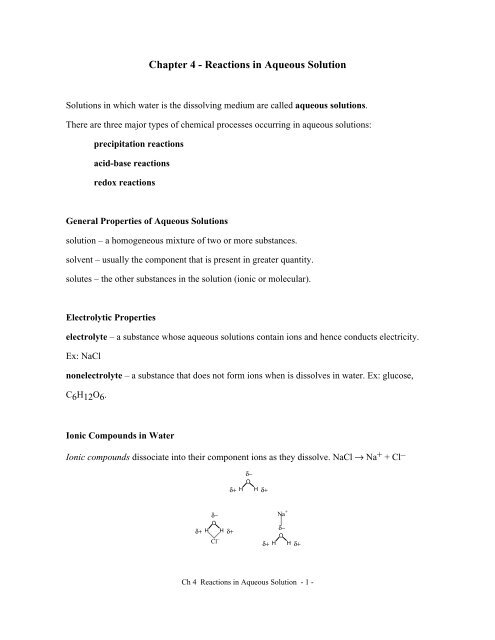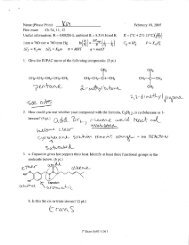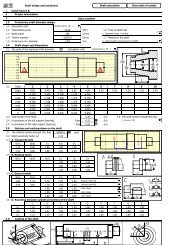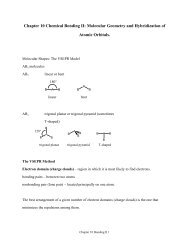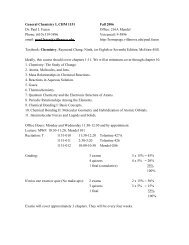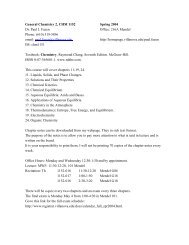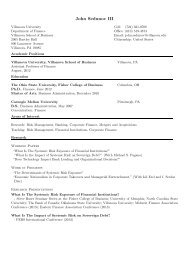Chapter 4 - Reactions in Aqueous Solution
Chapter 4 - Reactions in Aqueous Solution
Chapter 4 - Reactions in Aqueous Solution
Create successful ePaper yourself
Turn your PDF publications into a flip-book with our unique Google optimized e-Paper software.
<strong>Chapter</strong> 4 - <strong>Reactions</strong> <strong>in</strong> <strong>Aqueous</strong> <strong>Solution</strong><strong>Solution</strong>s <strong>in</strong> which water is the dissolv<strong>in</strong>g medium are called aqueous solutions.There are three major types of chemical processes occurr<strong>in</strong>g <strong>in</strong> aqueous solutions:precipitation reactionsacid-base reactionsredox reactionsGeneral Properties of <strong>Aqueous</strong> <strong>Solution</strong>ssolution – a homogeneous mixture of two or more substances.solvent – usually the component that is present <strong>in</strong> greater quantity.solutes – the other substances <strong>in</strong> the solution (ionic or molecular).Electrolytic Propertieselectrolyte – a substance whose aqueous solutions conta<strong>in</strong> ions and hence conducts electricity.Ex: NaClnonelectrolyte – a substance that does not form ions when is dissolves <strong>in</strong> water. Ex: glucose,C6H12O6.Ionic Compounds <strong>in</strong> WaterIonic compounds dissociate <strong>in</strong>to their component ions as they dissolve. NaCl → Na+ + Cl–δ−Oδ+ H H δ+δ−Na +Oδ+ H Hδ−δ+OCl – δ+ H H δ+Ch 4 <strong>Reactions</strong> <strong>in</strong> <strong>Aqueous</strong> <strong>Solution</strong> - 1 -
Molecular Compounds <strong>in</strong> WaterMost molecular compounds do not form ions when they dissolve <strong>in</strong> water; they arenonelectrolytes.Important exceptions are acids and compounds such as ammonia that react with water to formions.Strong and Weak ElectrolytesStrong electrolytes exist <strong>in</strong> solution completely or nearly completely as ions. Ex: KBr, HCl.Weak electrolytes produce small concentrations of ions when they dissolve.Do not confuse the extent to which an electrolyte dissolves with whether it is a strong or weakelectrolyte.CH 3 COOH CH 3 COO – + H +K a= [H + ][CH 3COO − ]= 1.8 × 10 −5[CH 3COOH]chemical equilibriumAn aqueous strong electrolyte solution consists of ions that are free to move through the solvent.The solutes <strong>in</strong> nonelectrolyte solutions are present as molecules.Only a small fraction of molecules <strong>in</strong> weak electrolyte solutions are present as ions.Ch 4 <strong>Reactions</strong> <strong>in</strong> <strong>Aqueous</strong> <strong>Solution</strong> - 2 -
Solubility Guidel<strong>in</strong>es for Ionic CompoundsThe solubility of a substance is the amount of that substance that can be dissolved <strong>in</strong> a givenquantity of solvent.Any substance with the solubility of less than 0.001 mol/L will be referred to as <strong>in</strong>soluble.–All common ionic compounds that conta<strong>in</strong> the nitrate anion, NO 3 , are soluble <strong>in</strong> water.All common ionic compounds of the alkali metal ions (group 1A) and of the ammonium ion,+NH 4 , are soluble <strong>in</strong> water.A rule of thumb• A compound is probably soluble if it conta<strong>in</strong>s one of the follow<strong>in</strong>g cations:• Group 1A cation: Li + , Na + , K + , Rb + , Cs ++• Ammonium ion: NH 4• A compound is probably soluble if it conta<strong>in</strong>s one of the follow<strong>in</strong>g anions:• Halides: Cl – , Br – , I –Except Ag + , Hg 22+ , and Pb2+ compounds• Nitrate (NO 3– ), perchlorate (ClO4– ), acetate (CH3 CO 2– ), sulfate (SO42– )Except Ba 2+ 2+ 2+, Hg 2 , and Pb sulfates.• A compound is probably <strong>in</strong>soluble if it conta<strong>in</strong>s one of the follow<strong>in</strong>g anions:• Carbonate (CO3 2– ), phosphate (PO4 3– ), chromate (CrO4 2– ), sulfides (S2 – )Except compounds conta<strong>in</strong><strong>in</strong>g alkali metal (Group 1A) ions and the ammonium ion.• Hydroxides (OH – )• Except compounds conta<strong>in</strong><strong>in</strong>g alkali metal (Group 1A) ions and the Ba2+ ion.Ch 4 <strong>Reactions</strong> <strong>in</strong> <strong>Aqueous</strong> <strong>Solution</strong> - 4 -
Exchange (Metathesis) <strong>Reactions</strong>AX + BY → AY + BXAgNO 3( aq)+ KCl ( aq)→ AgCl( s) + KNO 3( aq)One of the follow<strong>in</strong>g is needed to drive a metathesis reaction:• the formation of a precipitate• the generation of a gas• the production of a weak electrolyte• the production of a nonelectrolyte.Acid-Base <strong>Reactions</strong>Acids are substances that are able to ionize <strong>in</strong> aqueous solutions to form a hydrogen ion (H + ) andthereby <strong>in</strong>crease the concentration of H + (aq) ions. (Arrhenius def<strong>in</strong>ition)Bronsted acid - proton donor.Monoprotic acid - each unit of acid yields one hydrogen ion.HCl ( aq )→ H + ( aq) + Cl− ( aq)Diprotic acid - each unit of acid gives up two H+ ions, <strong>in</strong> two separate steps.H 2 SO 4 ( aq) → H + −( aq) + HSO 4 ( aq)−HSO 4 ( aq)→ H+ ( aq)+2− SO4 ( aq)Net equationH 2 SO 4 ( aq) → 2H + 2−( aq) + SO 4 ( aq)Ch 4 <strong>Reactions</strong> <strong>in</strong> <strong>Aqueous</strong> <strong>Solution</strong> - 5 -
Triprotic acids - yield three H+ ionsH 3PO 4( aq)→ H + ( aq ) + H 2 PO 4 − ( aq)−H 2 PO 4 ( aq ) → H+( aq) + HPO 4 2− ( aq)2−HPO 4 ( aq)→ H+( aq) + PO 4 3− ( aq)net equationH 3 PO 4 ( aq)→ 3 H + ( aq ) + PO 4 3− ( aq )Bases are substances that accept (react with) H + ions.(Bronsted)H + ( aq) + OH − ( aq) → H 2 O ( l)NH 3 ( aq) + H +2O ( l)→ NH 4 ( aq)+ OH − ( aq)Bases <strong>in</strong>crease the concentration of OH – (aq) ions <strong>in</strong> water. (Arrhenius def<strong>in</strong>ition)Strong and Weak Acids and BasesAcids and bases that are strong electrolytes are called strong acids and strong bases.Those that are weak electrolytes are weak acids and weak bases.Molecular Formula Acid Name Anion Name of AnionHCl, Hydrogen chloride Hydrochloric acid Cl – ChlorideHBr, Hydrogen bromide Hydrobromic acid Br – BromideHI, Hydrogen Iodide Hydroiodic acid I – IodideHNO 3Nitric acid NO 3– NitrateHClO 4Perchloric acid ClO 4– PerchlorateHClO3 Chloric acid ClO3 – ChlorateH 2 SO 4Sulfuric acid SO 42– SulfateCh 4 <strong>Reactions</strong> <strong>in</strong> <strong>Aqueous</strong> <strong>Solution</strong> - 6 -
What’s the difference between HCl(g), hydrogen chloride, and HCl(aq), hydrochloric acid?Weak Acids are <strong>in</strong>completely deprotonated <strong>in</strong> solution.Ex: HF, HNO2, H2SO3, H3PO4, CH3COOH (acetic acid)BasesStrong bases: all Group 1A hydroxides, (LiOH, NaOH, KOH, RbOH, CsOH) and Ba(OH)2.Be(OH)2 and Mg(OH)2 are <strong>in</strong>soluble and Ca(OH)2 and Sr(OH)2 are slightly soluble.Weak bases: The most common weak base is NH3. Most other weak bases are derivatives ofammonia called am<strong>in</strong>es.NH3(aq) + H2O(l)NH4 + (aq) + OH–(aq)Neutralization <strong>Reactions</strong> and SaltsA neutralization reaction occurs when a solution of an acid and that of a base are mixed toproduce a salt (and water if the base is strong).HCl ( aq )+ NaOH ( aq )→ H 2O ( l )+ NaCl ( aq )( acid) ( base) ( water) ( salt)net ionicH + ( aq) + OH − ( aq) → H 2 O ( l)Ch 4 <strong>Reactions</strong> <strong>in</strong> <strong>Aqueous</strong> <strong>Solution</strong> - 7 -
Pay attention to stoichiometryHCl(aq) + NaOH(aq) → H2O(l) + NaCl(aq)HCl(aq) + Ba(OH)2(aq) → 2 H2O(l) + BaCl2(aq)H2SO4(aq) + 2 NaOH(aq) → 2 H2O(l) + Na2SO4(aq)Weak acid and strong baseHCN(aq) + NaOH(aq) → H2O(l) + NaCN(aq)Weak base and strong acidHNO3(aq) + NH3(aq) → NH4NO3(aq)In solution, NH3 reacts with water to produce NH4 + and OH–.HNO3(aq) + NH4 + (aq) + NO3 – (aq) → H2O(l) + NH4NO3(aq)Acid-Base <strong>Reactions</strong> with Gas Formation2HCl ( aq)+ Na 2 S ( aq)→ H 2 S ( g)+ 2NaCl ( aq)2H + ( aq) + S 2− ( aq) → H 2 S ( g)Carbonates and BicarbonatesHCl ( aq)+ NaHCO 3 ( aq) → H 2 CO 3( aq) + NaCl ( aq)H 2 CO 3 ( aq) → H 2O ( l)+ CO 2 ( g)H + +( aq) +HCO 3 ( aq)→ H2 O ( l)+ CO 2( g)Ch 4 <strong>Reactions</strong> <strong>in</strong> <strong>Aqueous</strong> <strong>Solution</strong> - 8 -
Oxidation –Reduction <strong>Reactions</strong>Loss of electrons by a substance is called oxidation.The ga<strong>in</strong> of electrons by a substance is reduction.Oxidation of one substance is always accompanied by the reduction of another as electrons aretransferred between them.LEO-GERLoss of Electrons-OxidationGa<strong>in</strong> of Electrons-ReductionOIL RIGOxidation Is Loss of electronsReduction Is Ga<strong>in</strong> of electronsOxidation NumbersThe oxidation number of an atom <strong>in</strong> a substance is the actual charge of the atom if it is amonatomic ion.• For an atom <strong>in</strong> its elemental form, the oxidation number is always zero.• For any monatomic ion, the oxidation number equals the charge on the ion.• Nonmetals usually have negative oxidation numbers, although they can sometimes bepositive.• The oxidation number of oxygen is usually –2 <strong>in</strong> both ionic and molecular compounds. Themajor exception is <strong>in</strong> compounds called peroxides, which conta<strong>in</strong> O 2- 2 ion, giv<strong>in</strong>g eachoxygen an oxidation number of –1.• The Oxidation number of hydrogen is +1 when bonded to nonmetals and –1 when bonded tometals.Ch 4 <strong>Reactions</strong> <strong>in</strong> <strong>Aqueous</strong> <strong>Solution</strong> - 9 -
• The oxidation number of fluor<strong>in</strong>e is –1 <strong>in</strong> all compounds. The other halogens have anoxidation number of –1 <strong>in</strong> most b<strong>in</strong>ary compounds. When comb<strong>in</strong>ed with oxygen, as <strong>in</strong>oxyanions, they have positive oxidation states.• The sum of the oxidation numbers of all atoms <strong>in</strong> a neutral compound is zero. The sum of theoxidation numbers <strong>in</strong> a polyatomic ion equals the charge of the ion.Maximum oxidation number = group number.M<strong>in</strong>imum oxidation number = group number – 8.ex: NO 3– Oxidation number of N is +5.NH 3 Oxidation number of N is –3.Substances that are oxidized are reduc<strong>in</strong>g agents.Substances that are reduced are oxidiz<strong>in</strong>g agents.Types of Redox <strong>Reactions</strong>• Comb<strong>in</strong>ation reactionsC(s) + O 2 (g) → CO 2 (g)3Mg(s) + N 2 (g) → Mg 3 N 2 (g)• Decomposition <strong>Reactions</strong>2KClO 3 (s) → 2KCl(s) + 3O 2 (g)• Displacement <strong>Reactions</strong>Ch 4 <strong>Reactions</strong> <strong>in</strong> <strong>Aqueous</strong> <strong>Solution</strong> - 10 -
Oxidation of Metals by Acids and SaltsA + BX → AX + BZn ( s)+ 2HBr ( aq)→ ZnBr 2 ( aq) + H 2( g)Mn ( s)+ Pb( NO 3 ) 2( aq→ Mn NO )( 3 ) 2( aq+ Pb ) ( s)These reactions are called displacement reactions because the ion <strong>in</strong> solution is displace orreplaced through oxidation of an element.Whenever one substance is oxidized, some other substance must be reduced.Hydrogen Displacement2Na(s) + 2H 2 O(l) → 2NaOH(aq) + H 2 (g)Zn(s) + 2HCl(aq) → ZnCl 2 (aq) + H 2 (g)Halogen DisplacementF 2 >Cl 2 > Br 2 > I 2Cl 2 (g) + 2KBr(aq) → 2KCl(aq) + Br 2 (l)Cl 2 (g) + 2KF(aq) → no reactionCh 4 <strong>Reactions</strong> <strong>in</strong> <strong>Aqueous</strong> <strong>Solution</strong> - 11 -
The Activity SeriesAny metal on the list can be oxidized by the ions of elements below it.Cu ( s)+ 2Ag + ( aq) → Cu 2+ ( aq) + 2Ag ( s)Cu is higher on activity series.Zn 2+ ( aq) + Cu( s) → No Reaction Zn is higher on activity series.Notice: The element that ends up as the cation is higher on the activity series.2 Na(s) + Sn2+(aq) → 2 Na+(aq) + Sn(s)A2+(aq) + B(s) → A(s) + B2+(aq)Ch 4 <strong>Reactions</strong> <strong>in</strong> <strong>Aqueous</strong> <strong>Solution</strong> - 12 -
Activity Series of Metals <strong>in</strong> <strong>Aqueous</strong> <strong>Solution</strong>MetalOxidation ReactionLithium Li(s) → Li + (aq) + e –Potassium K(s) → K + (aq) + e –Barium Ba(s) → Ba 2+ (aq) + 2e –Calcium Ca(s) → Ca 2+ (aq) + 2e –Sodium Na(s) → Na + (aq) + e –Magnesium Mg(s) → Mg 2+ (aq) + 2e –Alum<strong>in</strong>um Al(s) → Al 3+ (aq) + 3e –Manganese Mn(s) → Mn 2+ (aq) + 2e –Z<strong>in</strong>c Zn(s) → Zn 2+ (aq) + 2e –Chromium Cr(s) → Cr 3+ (aq) + 3e –Iron Fe(s) → Fe 2+ (aq) + 2e –Cobalt Co(s) → Co 2+ (aq) + 2e –Nickel Ni(s) → Ni 2+ (aq) + 2e –T<strong>in</strong> Sn(s) → Sn 2+ (aq) + 2e –Lead Pb(s) → Pb 2+ (aq) + 2e –Hydrogen H 2 (g) →2H + (aq) + 2e –Copper Cu(s) → Cu 2+ (aq) + 2e –Silver Ag(s) → Ag + (aq) + e –Mercury Hg(l) → Hg 2+ (aq) + 2e –Plat<strong>in</strong>um Pt(s) → Pt 2+ (aq) + 2e –Gold Au(s) → Au 3+ (aq) + 3e –Ch 4 <strong>Reactions</strong> <strong>in</strong> <strong>Aqueous</strong> <strong>Solution</strong> - 13 -
Concentrations of Reactants <strong>in</strong> <strong>Solution</strong>: MolarityMolarity =moles solutevolume of soln <strong>in</strong> litersExpress<strong>in</strong>g the Concentration of an electrolyteThe concentration of an electrolyte <strong>in</strong> solution can be specified either <strong>in</strong> terms of the compoundused to make the solution or <strong>in</strong> terms of the ions that that the solution conta<strong>in</strong>s.Ex: 1.0 M Na 2 SO 4 or 2.0 M Na + or 1.0 M SO 4 2– .Interconvert<strong>in</strong>g Molarity, Moles, and VolumeUse dimensional analysismoles = liters × molaritymoles = liters × moleslitersHow many moles of solute are present <strong>in</strong> the follow<strong>in</strong>g solution?35.00 mL of 1.200 M HNO 3How many mL of a 0.45 M BaCl 2 solution will conta<strong>in</strong> 15.0 g of BaCl 2 ?Ch 4 <strong>Reactions</strong> <strong>in</strong> <strong>Aqueous</strong> <strong>Solution</strong> - 14 -
Dilut<strong>in</strong>g Concentrated <strong>Solution</strong>sDilution<strong>Solution</strong>s of lower concentration can be obta<strong>in</strong>ed by add<strong>in</strong>g water to concentrated solutions, aprocess called dilution.Moles of solute before dilution = moles of solute after dilution.Moles = molarity × volumeM i× V i= M f× V fV i= M f× V fM iA bottle of 12.0 M hydrochloric acid has only 35.7 mL left <strong>in</strong> it. What will the HCl concentrationbe if the solution is diluted to 250.0 mL?What is the volume of solution that would result by dilut<strong>in</strong>g 70.00 mL of 0.0913 M NaOH to aconcentration of 0.0150 M?Ch 4 <strong>Reactions</strong> <strong>in</strong> <strong>Aqueous</strong> <strong>Solution</strong> - 15 -
<strong>Solution</strong> Stoichiometryfor the balanced equation:a A + b B c C + d DVolume ofsolution of AMoles of A Moles of B Volume ofsolution of BUse molarity of A asa conversion factorUse coefficients <strong>in</strong>the balancedequations to f<strong>in</strong>emole ratiosUse molarity of Bas a conversionfactorButane thiol (C 4 H 10 S) can be deodorized by reaction with household bleach (NaOCl) accord<strong>in</strong>gto the follow<strong>in</strong>g equation.2 C 4 H 10 S + NaOCl (aq) → C 8 H 18 S 2 + NaCl(aq) + H 2 O (aq)How many mL of 0.0500 M butanethiol can be deodorized by reaction with 5.00 mL of 0.0985M NaOCl?Ch 4 <strong>Reactions</strong> <strong>in</strong> <strong>Aqueous</strong> <strong>Solution</strong> - 16 -
Gravimetric Analysis - an analytical technique based on the measurement of mass.Calculate the concentration of an aqueous KCl solution if 25.00 mL of the solution gives 0.430 gof AgCl when treated with excess AgNO 3 .TitrationFor the balanced equation:NaOH +HCl NaCl + H 2 OVolume ofNaOHMoles ofNaOHMoles ofHClVolume ofHClUse molarity ofNaOH as aconversion factorUse coefficients <strong>in</strong>the balancedequations to f<strong>in</strong>dmole ratiosDivide by molarityof HClWhat volume of 0.250 M HCl is required to titrate 36.85 mL of 0.102 M NaOH?Ch 4 <strong>Reactions</strong> <strong>in</strong> <strong>Aqueous</strong> <strong>Solution</strong> - 17 -
Redox TitrationsIod<strong>in</strong>e, I 2 , reacts with aqueous thiosulfate ion <strong>in</strong> neutral solution accord<strong>in</strong>g to the balancedequation:2– – 2–I 2 (aq) + 2 S 2 O 3 (aq) → 2 I (aq) + S4 O 6 (aq)How many grams of I 2 are present <strong>in</strong> a solution if 35.20 mL of 0.150 M solution is needed totitrate the I 2 solution?Ch 4 <strong>Reactions</strong> <strong>in</strong> <strong>Aqueous</strong> <strong>Solution</strong> - 18 -


